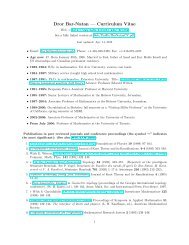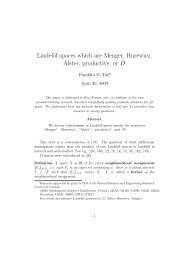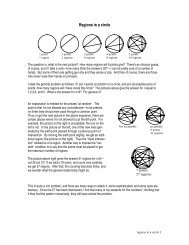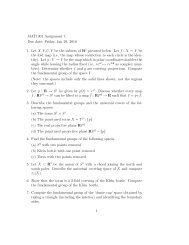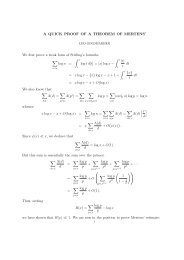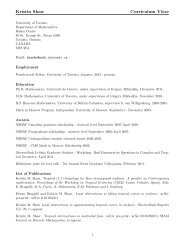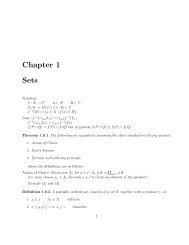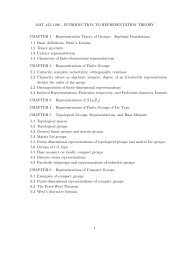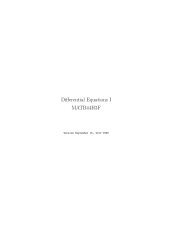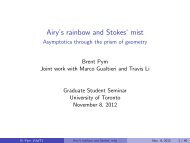Regions in a circle
Regions in a circle
Regions in a circle
Create successful ePaper yourself
Turn your PDF publications into a flip-book with our unique Google optimized e-Paper software.
The first th<strong>in</strong>g they do is a fast “successive differences” on the<br />
R-values and they get the table at the right. The last column is<br />
certa<strong>in</strong>ly compell<strong>in</strong>g. What if that pattern cont<strong>in</strong>ues? What if<br />
the next entry <strong>in</strong> that column is a 5? I leave it to you to show<br />
that the next R-value would then be R(8)=99. Could this be<br />
correct? What sort of argument would we need to establish<br />
that? Perhaps we might try to relate the numbers <strong>in</strong> the difference<br />
table to the geometry of the l<strong>in</strong>es and regions, so that we<br />
could “see” the pattern <strong>in</strong> the table not just numerically, but<br />
geometrically.<br />
Okay. We are <strong>in</strong>terested <strong>in</strong> “differences” <strong>in</strong> successive R values,<br />
so let’s ask what happens to R when we add a new po<strong>in</strong>t.<br />
How many new regions do we get?<br />
Well, each new po<strong>in</strong>t necessitates the draw<strong>in</strong>g of a number of<br />
new l<strong>in</strong>es, and each of these new l<strong>in</strong>es will create a number of<br />
new regions. But how many?<br />
The key observation (which was also the idea beh<strong>in</strong>d our<br />
analysis of the cutt<strong>in</strong>g planes problem) is that this new l<strong>in</strong>e<br />
creates new regions by slic<strong>in</strong>g through old regions and cutt<strong>in</strong>g<br />
them <strong>in</strong> two, and the number of new regions created is the<br />
number of old regions this l<strong>in</strong>e slices! And a nice way to th<strong>in</strong>k<br />
about that, is to notice that each time the l<strong>in</strong>e <strong>in</strong>tersects an<br />
exist<strong>in</strong>g l<strong>in</strong>e, it leaves one old region and enters another, so the<br />
number of old regions it encounters is one more than the number<br />
of old l<strong>in</strong>es it meets.<br />
We need some notation. We are focus<strong>in</strong>g on l<strong>in</strong>es and <strong>in</strong>tersections<br />
of l<strong>in</strong>es, so let's keep track of the number of each at<br />
each stage. Let L denote the total number of l<strong>in</strong>es, I the number<br />
of <strong>in</strong>tersections of l<strong>in</strong>es (<strong>in</strong>side the <strong>circle</strong>) and R as before<br />
the number of regions. If we tabulate these quantities for the<br />
first seven pictures, we get the table at the right.<br />
I ask the class to f<strong>in</strong>d patterns <strong>in</strong> the table, and immediately we<br />
get the observation that:<br />
R = 1 + L + I.<br />
Hmm. This is nice, because if it's true, then we can obta<strong>in</strong> the<br />
R-column by figur<strong>in</strong>g out the (possibly simpler) L-column and Icolumn.<br />
But why should the above equation hold? Aga<strong>in</strong> we have a<br />
numerical observation that we would like to verify with a geometric<br />
argument.<br />
n R<br />
1 1<br />
2 2<br />
1<br />
1<br />
2 1<br />
3 4 2<br />
4 2<br />
4 8 4<br />
8 3<br />
5 16 7<br />
15 4<br />
6 31 11<br />
26<br />
7 57<br />
The last column of the table is<br />
certa<strong>in</strong>ly nice. But one of the<br />
students notes that we’ve seen<br />
the third column before—the<br />
sequence 1, 2, 4, 8, 15, 26 gives<br />
the number of regions when 3space<br />
is cut by 0, 1, 2, 3 etc.<br />
planes <strong>in</strong> general position! Holy<br />
cow! [See problem 3]<br />
n L I R<br />
1 0 0 1<br />
2 1 0 2<br />
3 3 0 4<br />
4 6 1 8<br />
5 10 5 16<br />
6 15 15 31<br />
7 21 35 57<br />
regions <strong>in</strong> a <strong>circle</strong> 2



